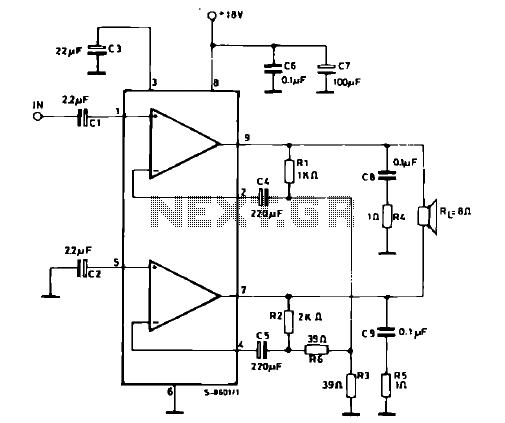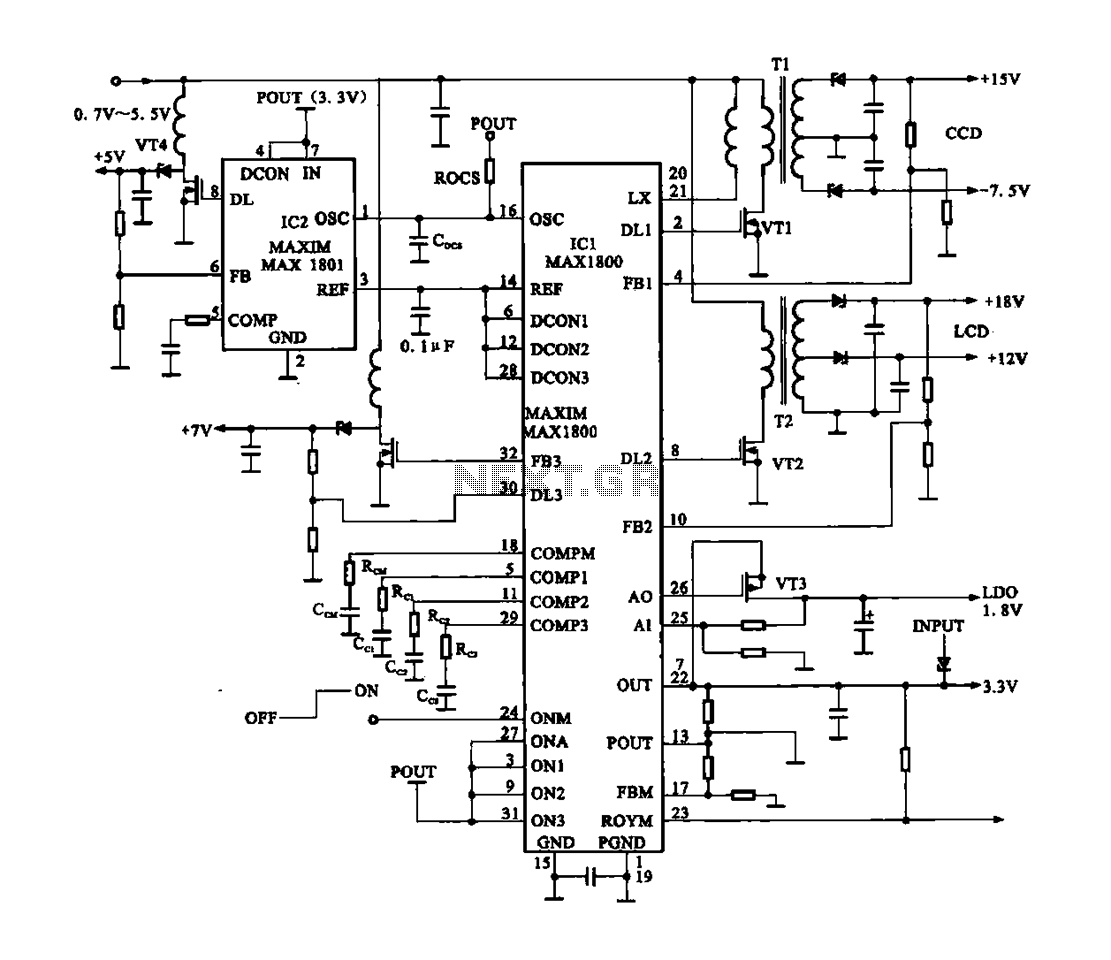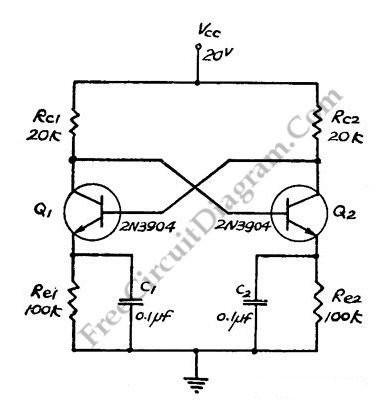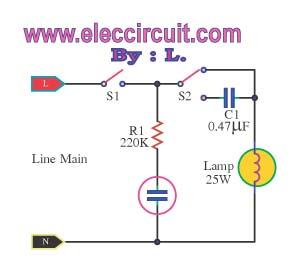
Superior performance combination of home theater AV circuit
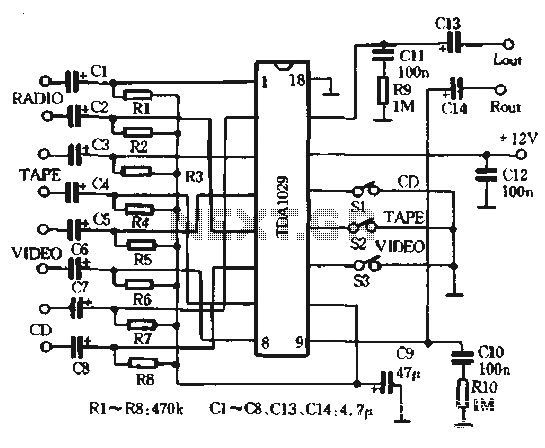
The AV combination as depicted in the diagram involves the first stage using the Philips TDA1029, which functions as a four-input switching signal processor. The second stage employs the NE5532 as a preamplifier, while the B of the NEC, the company pPC18 92 is also involved. This configuration features a four-way surround processing circuit designed for the main signal, surround, and center signal output, along with controls for high and low tones, volume, left and right balance, surround effect, and three types of analog sound effect selection. The third level utilizes the MS381 to drive the front pair of speakers, optimizing the three-dimensional sound field effect. The power output stage includes the TDA1514A or TDA1521 (or LM1875). The TDA1029 is recognized as a quad switching IC for stereo audio applications in high-fidelity audio signal processing. It operates within a voltage range of 6 to 23V, with a typical value of 12V, and boasts a total harmonic distortion of only 0.005%, alongside an excellent signal-to-noise ratio of 120 dB and a conversion rate of 5-15V/µs. The typical applications of this circuit are illustrated in the accompanying figures. The PC1892, introduced in 1995, is a high-performance four-channel surround processing circuit that utilizes a phase-shift ring matrix surround sound processing system. It separates dual-channel signals and a mono signal into the main channel and surround channel signals, with a center channel signal path. The circuit offers modes for concert hall, cinema, and hospital stereo, as well as analog stereo straight sound field effects. It includes internal surround sound effect control, main amplifier balance, bass, and volume control, with DC level control to minimize circuit noise. The PC1892 features an internal discharge amplifier, low-pass filter, phase shifting control mode, effect processing, absorption compensation, pitch, volume, and balance controls. The application circuit demonstrates typical operating voltages of +12V and +5V for the tone control section. The PC1892 is controlled by analog inputs, with programmed process control for each potentiometer. The functions of the potentiometers are as follows: RP1 controls the back surround channel sound volume, RP2 manages the front left and right ear balance, RP3 adjusts the left and right channel volume, RP4 regulates the front center channel volume, and RP5 and RP6 handle the front left and right channel low and treble tone controls. The toggle switches S1 and S2 serve the following roles: S1 high and S2 low activate concert hall mode; S1 low and S2 high activate cinema mode; both S1 and S2 high enable analog stereo mode; and both S1 and S2 low set the stereo pass-through port state.
The AV combination circuit described integrates advanced audio processing components to deliver a high-quality surround sound experience. The TDA1029 quad switching IC serves as the backbone for audio signal routing, allowing seamless transitions between multiple audio sources. Its low total harmonic distortion and high signal-to-noise ratio ensure that the audio output remains clean and clear, critical for high-fidelity applications.
The NE5532 preamplifier enhances the audio signal further, providing necessary gain while maintaining the integrity of the sound. The inclusion of the MS381 for speaker driving is pivotal in achieving a rich three-dimensional sound field, enhancing the auditory experience by accurately reproducing spatial audio cues.
The PC1892, with its sophisticated surround processing capabilities, employs a phase-shift ring matrix system that effectively creates a surround sound environment. This is particularly beneficial in applications where immersive audio is required, such as home theaters or gaming setups. The ability to toggle between different sound modes—concert hall, cinema, and hospital stereo—adds versatility, allowing users to tailor the audio output to their specific needs.
The control interface, featuring multiple potentiometers and toggle switches, provides users with intuitive access to adjust volume levels, balance, and tone settings. This design consideration enhances user experience, allowing for quick adjustments to the audio characteristics without extensive navigation through complex menus.
Overall, the circuit exemplifies a comprehensive approach to audio processing, combining high-performance components with user-friendly controls to create a robust AV system capable of delivering superior sound quality across various applications.The AV combination as shown in lo-2, the first stage Philips TDA1029 four-input switching signal for the switch; the second stage uses NE5532 as preamplifier, B of the NEC, the company pPC18 92 four -way surround processing circuit for the main signal and surround, center signal output, and for high and low tones, volume, left and right balance, surround effect control and three types of analog sound effect selection; the third level using MS381 as the front pair of speakers to achieve the best of the three-dimensional sound field effect processing; conjugate end and the TDA1514A TDA15 21 (or LM1875) for power output out. TDA1029 is a Quad for stereo audio in the field of high fidelity audio signal switching ICs. Operating voltage: 6 ~ 23V, typical type of value 12V, total harmonic distortion of only 0.00 5%, excellent signal to noise ratio (stare t = 120dB), the conversion rate 5-15V / Ftso typical applications of the circuit shown in Figure 10-3 shown.
ruPC1892 was introduced in 1995 high performance four-channel surround processing circuit, which uses phase-shift ring matrix surround sound processing system, dual-channel signal and a mono signal separating two main channel signal and all the way to the surround channel signal, a center channel signal path (actually found when creating two vice-channel p PC1892 in the signal all the way to the center signal) o the circuit is provided with a concert hall, cinema and hospital stereo and analog stereo straight sound field effect mode. Circuit with internal surround sound effect control, the main amplifier balance, bass and volume control, equipment control part of the system are used in the DC level of control "ridicule, so that the circuit noise is reduced to very low limits.
Anal P ( '1892 with internal discharge amplifier, low-pass filter, a phase shifting control mode, effect processing fruit, absorption compensation, pitch, volume, balance .pcPC1892 is an LSI circuit, the application circuit in FIG. 10-4 shows the typical operating voltage of + 12V, + 5V tone control section with technical mode. PC1892 is controlled by the anal , feet high and low programmed process control for each potentiometer functions as follows:.
RP1 is back surround channel sound volume control, RPZ for the front left and right ear balance control, RP3 for the left and right channel volume control, RP4 for the front center channel volume control, RP5, RP6 are front left and right channel low, treble tone control . Toggle si, S2's role: sl high, sz low as concert hall mode; sl low, S2 is high cinema mode; sl, SZ are high level analog stereo mode; Sl .
S2 are low for the stereo pass-through port state
The AV combination circuit described integrates advanced audio processing components to deliver a high-quality surround sound experience. The TDA1029 quad switching IC serves as the backbone for audio signal routing, allowing seamless transitions between multiple audio sources. Its low total harmonic distortion and high signal-to-noise ratio ensure that the audio output remains clean and clear, critical for high-fidelity applications.
The NE5532 preamplifier enhances the audio signal further, providing necessary gain while maintaining the integrity of the sound. The inclusion of the MS381 for speaker driving is pivotal in achieving a rich three-dimensional sound field, enhancing the auditory experience by accurately reproducing spatial audio cues.
The PC1892, with its sophisticated surround processing capabilities, employs a phase-shift ring matrix system that effectively creates a surround sound environment. This is particularly beneficial in applications where immersive audio is required, such as home theaters or gaming setups. The ability to toggle between different sound modes—concert hall, cinema, and hospital stereo—adds versatility, allowing users to tailor the audio output to their specific needs.
The control interface, featuring multiple potentiometers and toggle switches, provides users with intuitive access to adjust volume levels, balance, and tone settings. This design consideration enhances user experience, allowing for quick adjustments to the audio characteristics without extensive navigation through complex menus.
Overall, the circuit exemplifies a comprehensive approach to audio processing, combining high-performance components with user-friendly controls to create a robust AV system capable of delivering superior sound quality across various applications.The AV combination as shown in lo-2, the first stage Philips TDA1029 four-input switching signal for the switch; the second stage uses NE5532 as preamplifier, B of the NEC, the company pPC18 92 four -way surround processing circuit for the main signal and surround, center signal output, and for high and low tones, volume, left and right balance, surround effect control and three types of analog sound effect selection; the third level using MS381 as the front pair of speakers to achieve the best of the three-dimensional sound field effect processing; conjugate end and the TDA1514A TDA15 21 (or LM1875) for power output out. TDA1029 is a Quad for stereo audio in the field of high fidelity audio signal switching ICs. Operating voltage: 6 ~ 23V, typical type of value 12V, total harmonic distortion of only 0.00 5%, excellent signal to noise ratio (stare t = 120dB), the conversion rate 5-15V / Ftso typical applications of the circuit shown in Figure 10-3 shown.
ruPC1892 was introduced in 1995 high performance four-channel surround processing circuit, which uses phase-shift ring matrix surround sound processing system, dual-channel signal and a mono signal separating two main channel signal and all the way to the surround channel signal, a center channel signal path (actually found when creating two vice-channel p PC1892 in the signal all the way to the center signal) o the circuit is provided with a concert hall, cinema and hospital stereo and analog stereo straight sound field effect mode. Circuit with internal surround sound effect control, the main amplifier balance, bass and volume control, equipment control part of the system are used in the DC level of control "ridicule, so that the circuit noise is reduced to very low limits.
Anal P ( '1892 with internal discharge amplifier, low-pass filter, a phase shifting control mode, effect processing fruit, absorption compensation, pitch, volume, balance .pcPC1892 is an LSI circuit, the application circuit in FIG. 10-4 shows the typical operating voltage of + 12V, + 5V tone control section with technical mode. PC1892 is controlled by the anal , feet high and low programmed process control for each potentiometer functions as follows:.
RP1 is back surround channel sound volume control, RPZ for the front left and right ear balance control, RP3 for the left and right channel volume control, RP4 for the front center channel volume control, RP5, RP6 are front left and right channel low, treble tone control . Toggle si, S2's role: sl high, sz low as concert hall mode; sl low, S2 is high cinema mode; sl, SZ are high level analog stereo mode; Sl .
S2 are low for the stereo pass-through port state
